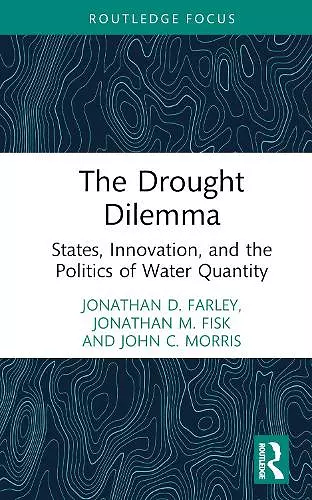The Drought Dilemma
States, Innovation, and the Politics of Water Quantity
John C Morris author Jonathan M Fisk author Jonathan D Farley author John C Morris editor
Format:Hardback
Publisher:Taylor & Francis Ltd
Published:16th Apr '24
Currently unavailable, and unfortunately no date known when it will be back

Water policy in United States is one of the most complex topics in the field of public policy. This book, a comparative study of Texas, California, and Alabama’s drought response, provides for the first time a common framework for analysis to investigate how water scarcity and droughts have interacted with various state-level factors to produce a wide degree of variance in policy innovations. Using Toddi Steelman’s (2010) conceptual framework, the authors examine multiple variables that impact water policy innovation, while showing how one policy solution does not fit all. They expertly demonstrate divergence in water policies due to the environmental cultures, water distribution, and structures in each case, despite similar drought conditions.
As water is increasingly stressed in the future, the ability to draw on lessons learned by these states will provide valuable insight to other entities that face droughts and water shortages. The Drought Dilemma is a must read for all those looking for recommendations for the construction of drought policy, as well as future approaches to understand comparative state drought policy.
As temperatures continue to rise and we experience a greater frequency of extreme weather, drought, and over-extraction of groundwater, effective water policy management is at a critical juncture. Farley, Fisk, and Morris explore these complexities through the study of three exceedingly divergent states: Alabama, California, and Texas. The approach highlights how water policy is driven as much by political culture, institutional characteristics, and historical context as it is by need and best practices. This work will unquestionably be of interest to policymakers and scholars interested in better understanding the complexities and challenges of state water policy.
—Martin Mayer, University of North Carolina at Pembroke
The Drought Dilemma stands out as a pivotal and enlightening read. This book skillfully navigates the challenging water drought policies in Alabama, Texas, and California, offering key insights into one of our time’s most pressing environmental challenges. Detailed interviews enhance the authors’ extensive research, illuminating the multifaceted aspects of drought management and water policy. This work reveals that the complexities of environmental problems and policy innovations defy simple categorizations like political ideology or regional location. By bringing the critical aspect of environmental resource distribution to the forefront, the book contributes significantly to our understanding of policy variations and their broader implications and serves as a vital guide for understanding and improving environmental policy. It’s an essential addition to the field, poised to influence both current discussions and future policy developments in water management. This book will make a valuable contribution to environmental and natural resource literature.
—David P. Adams, California State University at Fullerton
The Drought Dilemma presents an examination of water policy innovation through a comparative case study analysis across three states: California, Texas, and Alabama. This work underscores the dynamic nature of water problems in these states and the growing challenges facing state and local governments to address regional water issues through effective water management approaches. The central message, the efficacy of water management, requires innovative policy solutions that adapt to changing environmental conditions and mediate future water crises. This study offers environmental scholars, water management practitioners, and students interested in natural resource policy a unique framework to understand the complexities of state-level water policies and the importance of governmental response to meet current and future water needs.
—Luisa M. Diaz-Kope, University of North Georgia
ISBN: 9781032761374
Dimensions: unknown
Weight: 453g
128 pages